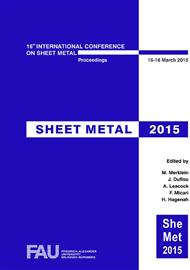[1]
S. Kalpakjian, S.R. Schmid, Manufacturing Processes for Engineering Materials, Person edition, New Delhi, India, (2003).
Google Scholar
[2]
A. Forcellese, F. Gabrielli, R. Ruffini, Effect of the training set size on springback control by neural network in an air bending process, Journal of Materials Processing Technology. 80–81 (1998) 493–500.
DOI: 10.1016/s0924-0136(98)00122-8
Google Scholar
[3]
B.T. Cheok, A.Y.C. Nee, Configuration of progressive dies, Artificial Intelligence for Engineering Design, Analysis and Manufacturing. 12 (1998) 405-418.
DOI: 10.1017/s0890060498125015
Google Scholar
[4]
D.H. Park, Y.K.D.V. Prasad, CAPP for Non-Axisymmetric Deep Drawing Products NUMIFORM 2004 - Proceeding of the 8thInternational Conference on Numerical Methods in Industrial Forming Processes (2004)1985-(1988).
Google Scholar
[5]
S. Kumar, R. Singh, A short note on an intelligent system for selection of materials for progressive die components, Journal of Materials Processing Technology. 182 (2007)456-461.
DOI: 10.1016/j.jmatprotec.2006.09.004
Google Scholar
[6]
H.M.A. Hussein, S. Kumar, A computerized retrieval system for sheet metal parts, Asian International Journal of Science and Technology in Production and Manufacturing. 1 (2) (2008)31-40.
Google Scholar
[7]
V. Naranje, S. Kumar, A knowledge based system for automated design of deep drawing die for axisymmetric parts, Expert Systems with Applications. 41 (4/1) (2014) 1419-1431.
DOI: 10.1016/j.eswa.2013.08.041
Google Scholar
[8]
R. Hambli, Optimization of Blanking Processes Using Neural Network Simulation, The Arabian Journal for Science and Engineering. 30 (2005)3-16.
Google Scholar
[9]
R. Hambli, F. Guerin, Application of a neural network for optimum clearance prediction in sheet metal blanking processes, Finite Elements in Analysis and Design. 39 (2003)1039–1052.
DOI: 10.1016/s0168-874x(02)00155-5
Google Scholar
[10]
J. Slomp, W. Klingenberg, A Proposal to Use Artificial Neural Networks for Process Control of Punching/Blanking Operations, Flexible Automation and Intelligent Manufacturing, FAIM2004 Toronto, Canada, (2004) 556-562.
Google Scholar
[11]
W. Liu, Q. Liu, F. Ruana, Z. Liang, H. Qiu, Springback prediction for sheet metal forming based on GA-ANN technology, Journal of Materials Processing Technology. 187–188 (2007)227–231.
DOI: 10.1016/j.jmatprotec.2006.11.087
Google Scholar
[12]
S.M. Hussaini, S.K. Singh, A. K. Gupta, Experimental and numerical investigation of formability for austenitic stainless steel 316 at elevated temperatures, Journal of Materials Research and Technology. 3(1) (2014)17-24.
DOI: 10.1016/j.jmrt.2013.10.010
Google Scholar
[13]
J. A. Graham, Fatigue Design Handbook, SAE, USA, (1968).
Google Scholar
[14]
V. Kazymyrovych, Very high cycle fatigue of tool steels, Ph.D. thesis, Karlstad University Studies, (2010).
Google Scholar


